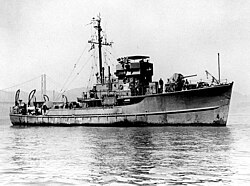YMS class
|
USS YMS-479
|
||||||||||||||
|
||||||||||||||
|
||||||||||||||
|
||||||||||||||
|
||||||||||||||
Auxiliary Motor Minesweeper was the US Navy name for light auxiliary minesweeper built and used during World War II . The more common term was yard minesweeper , from which the ship identifier YMS is derived. Since all the units built are identical, they are also referred to as the YMS class or YMS-1 class . As yard units, the YMS boats were normally permanently assigned to a port or naval base and their area of operation was limited to its area.
The first boat, YMS-1 , was laid down in March 1941 , and about a year later the Navy put the first units into service, first in Jacksonville and Charleston . After the start of the war, the boats were built in rapid mass production by 35 yacht builders (12 on the east coast , 19 on the west coast , 4 on the Great Lakes ); the shortest construction time was three and a half months. 481 boats were built, which only differed in one detail: the first 134 pieces had two small chimneys, numbers 135 to 445 and 480/481 only one, the rest none at all. The boats reached 15 knots , were about 41 meters (136 feet ) long, had a displacement of 270 tons, and were powered by two GM -8-268A diesel engines at 880 bhp ; the hull was made of wood. In defense withstood the 32-man crew, a 7.6-cm -Schiffsgeschütz, two 20 mm machine guns and two water bombers available.
During the war, YMS units were deployed in almost all theaters of war. Numerous models went to allies under the lend lease agreement , mainly to the French Navy and the Royal Navy . For the latter, a further 80 boats were produced, which were called British Motor Minesweepers ( BYMS ). Towards the end of the war, the Greek Navy also received nine YMS.
40 of the units were lost, most of them colliding with a mine while clearing the mine. The greatest loss occurred on October 9, 1945 when seven YMS in Okinawa were destroyed by Typhoon Louise .
After the war, most of the boats were soon taken out of service. The remaining units were reclassified as AMS in 1947 and named individually. In the Korean War , they were used again and played an important role as minesweepers. In 1955 the boats were given the new identification MSC (O) , and two years later the last YMS were removed from the active fleet. In the 1960s, the units were then only used to train reservists. The last U.S. boat in the class, USS Ruff (originally YMS-327 ), was retired in November 1969.
Five boats were also handed over to the German Navy and used there as test vehicles. These are Adolf Bestelmeyer (Y 881), built as YMS 213, Rudolf Diesel (Y 889), built as YMS 279, Hans Christian Oerstedt (Y 877), built as YMS 247, Hermann von Helmholz (Y 878) and OT 2 (W 54, later Y 847). The YMS numbers of the last two units are unclear. At least three other YMS went to South Vietnam . The BYMS-26 developed into the most famous boat of the class , which was given to the marine researcher Jacques-Yves Cousteau in 1950 and converted into the research vessel Calypso by him.
Web links
- Auxiliary Motor Minesweeper (YMS) on navsource.org (English)
- YMS class on uboat.net (English)
